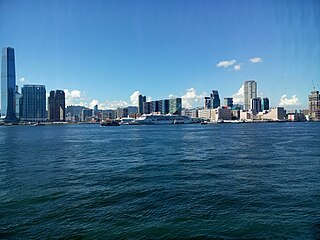
Kowloon is an urban area in Hong Kong comprising the Kowloon Peninsula and New Kowloon. With a population of 2,019,533 and a population density of 43,033/km2 in 2006, it is the most populous urban area in Hong Kong. The peninsula's area is about 47 km2 (18 sq mi).

Sha Tin District is one of the 18 districts of Hong Kong. As one of the 9 districts located in the New Territories, it covers the areas of Sha Tin, Tai Wai, Ma On Shan, Fo Tan, Siu Lek Yuen and Ma Liu Shui. The district is the most populous district in Hong Kong, with a population of 659,794 as per 2016 by-census, having a larger population than many countries or dependencies including Iceland, Malta, Montenegro and Brunei.

The Eastern Harbour Crossing, abbreviated as "EHC", is a combined road-rail tunnel that crosses beneath Victoria Harbour in Hong Kong. Opened on 21 September 1989, it connects Quarry Bay, Hong Kong Island and Cha Kwo Ling, Kowloon East.
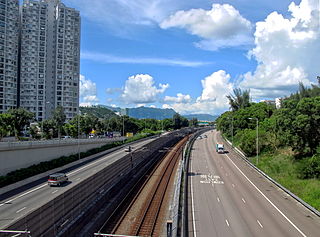
Tate's Cairn Highway, opened on 26 June 1991, is a dual 3-lane expressway in Hong Kong. It links Tate's Cairn Tunnel and Ma Liu Shui Interchange, forming a part of Route 2.
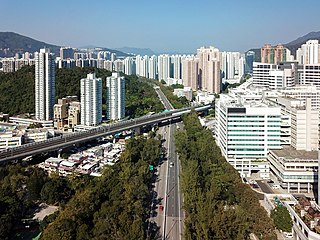
Sha Tin Road, opened on 6 November 1984, is a dual-2 lane expressway in Hong Kong. It links Lion Rock Tunnel Road and Tai Po Road — Sha Tin, forming a part of Route 1.
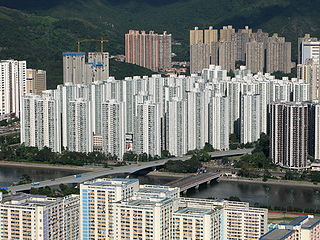
City One Shatin is a residential precinct in Sha Tin, New Territories, Hong Kong. The estate occupies approximately 1,800,000 square feet of land. The estate was named City One as it is on Lot 1, Shatin Town. It has a census area population of 24,758 people. City One is the largest private residential estate in Sha Tin District. There are a total of 52 blocks of residential buildings with 10,642 units. Each tower is about 30 storeys with units ranging from 389 square feet (36.1 m2) to an area of 1,018 square feet (94.6 m2), offering different floor plans.

Route 2 of Hong Kong is a series of expressways that runs from Quarry Bay of Hong Kong Island to Ma Liu Shui of the New Territories East, formerly known as route 6, and renamed as route 2 in 2004 under the route numbering scheme proposed in the same year. Route 2 consists of 4 parts, from South to North:
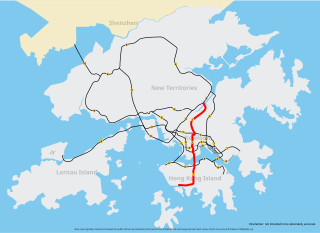
Route 1 is a major artery in Hong Kong that runs in a generally north-south direction, connecting Aberdeen with Sha Tin.

Sha Tin, also spelt Shatin, is a neighbourhood along Shing Mun River in the eastern New Territories, Hong Kong. Administratively, it is part of the Sha Tin District. Sha Tin is one of the neighbourhoods of the Sha Tin New Town project.

Sha Tin New Town, or known as Sha Tin-Ma On Shan New Town or Sha Tin Town is one of the satellite towns and new towns of Hong Kong. It is within the Sha Tin District, the New Territories. The New Town covers the neighbourhoods such as Sha Tin, Tai Wai, Fo Tan, Tai Shui Hang, Ma On Shan. The Shing Mun River runs through the middle of the town.
The Kwun Tong Bypass is an elevated expressway between Lam Tin and Kowloon Bay in Kwun Tong District, Kowloon East, Hong Kong, with three lanes in each direction and a posted speed limit of 70-80 kilometres per hour. It is part of Route 2 and has links to Route 5 and Route 7. It bypasses the industrial township of Kwun Tong and passes next to the boundary of the Kai Tak Airport.
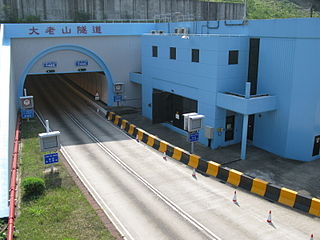
Tate's Cairn Tunnel is a four-lane road tunnel in Hong Kong. Constructed as part of Route 2, it links Diamond Hill, New Kowloon with Siu Lek Yuen, Sha Tin, New Territories East. It opened on 26 June 1991.

Tai Lam Tunnel, running along Tsing Long Highway, is part of Route 3 Country Park Section (R3CPS) and is a transport link between the western New Territories in Ting Kau and Yuen Long.

Temple Hill, also known as Tsz Wan Shan, is a hill between New Kowloon and the New Territories, Hong Kong. It peaks at 488 m. Beneath its south side is the residential area of Tsz Wan Shan and Buddhist temples. Sha Tin Pass runs between the hill and Unicorn Ridge.

The Hong Kong Strategic Route and Exit Number System is a system adopted by the Transport Department of the Hong Kong Government to organise the major roads in the territory into routes 1 to 10 for the convenience of drivers. When the system was implemented in 2004, the government promoted it with a major public campaign, including the slogan "Remember the Numbers; Make Driving Easier".

Autotoll Limited (Autotoll) provides Electronic Toll Collection (ETC) service in Hong Kong.

The Hong Kong government started developing new towns in the 1950s to accommodate Hong Kong's booming population. During the first phase of development, the newly developed towns were called "satellite towns", a concept borrowed from the United Kingdom, of which Hong Kong was a colony. Kwun Tong, located in eastern Kowloon, and Tsuen Wan, located in the south-west of the New Territories, were designated as the first satellite towns, when the urban area in Hong Kong was still relatively small, restricted to the central and western parts of Kowloon Peninsula and the northern side of Hong Kong Island. Wah Fu Estate was also built in a remote corner on the southern side of Hong Kong Island, with similar concepts but at a smaller scale.
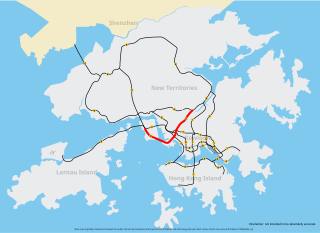
Tsing Sha Highway is a major expressway in Hong Kong, which links the island of Tsing Yi to Sha Tin. The road is part of Route 8, which starts in Sha Tin and terminates in Tung Chung. It was opened in March 2008 and extended in December 2009.



















